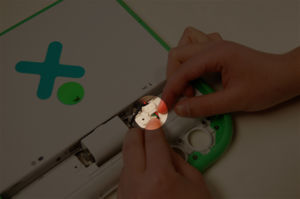User:DanielDrake/XO Troubleshooting Power
Did the EC boot?
Follow the Full Reset procedure, and check to see if the battery LED flashes orange momentarily after reapplying one source of power. The flash is very brief, less than half a second, and occurs only once each time the first source of power is applied.
If it didn't flash at all, you probably have a broken motherboard.
If it flashed another color (red or green), then you probably have a problem with the LED or LED driver circuitry.
To check the EC is running properly, try removing the battery and powering up the laptop without it. Replace the battery after the laptop is running.
The laptop emits a high pitched whine when using the power adapter
The whine is usually the result of lower-than-normal input voltage or current from the external adapter, e.g. charging with the portable PV panel. The whine comes from vibration in the coils in the inductor -- if the whine is extreme, and goes on for a very long time, there's some chance of the insulating varnish on the coils being harmed, but for all practical purposes, the whine is perfectly safe.
Laptop recognizes the battery, reads its charge percent & voltage properly but does not charge it
Another behaviour is that Laptop does not work without power source (despite being battery fully charged). It would go to a state of power off, and when you try to power it on, power & battery leds will toggle continiously while holding power on button pressed. But, for this problem, battery loads sugar and works properly all its functionalities when AC plugged.
- Solution: This problem fixes by replacing Q32 component, it's a transistor wich drains power to/from battery when charging/discharging.
The battery doesn't charge, yet the PV panel is connected and the sun is shining
In the first generation of XO's, the laptop's power management system would trigger a switch that would interrupt the powercables between the charging plug and the further interior of the XO when the PV panel would generate a spike voltage when the sun e.g. would come from behind the clouds. To close the switch again, you'd have to manually remove the battery for a moment and remount it. You would then hear the coils start zooming again and see the charging light come on again. This issue has been solved by e.g. by a Schottky diode or even more sophisticated PV power management technology that became standard integrated in the XO's.--SvenAERTS 11:36, 1 March 2012 (UTC)
If the laptop can't run from a known good power source:
- Does the battery charge LED indicate the laptop thinks it has power ? With a battery inserted, the battery LED should turn yellow or green within a minute of applying power. In this case, the laptop probably has a startup problem, not a power problem.
- Otherwise, the motherboard needs replacement.
- Suspect components are the fuse F1 (2A) and diode D21 (3A schottky) on the motherboard protecting the DC input. If the fuse was blown, check diode D123 (3A schottky) and diode D118]] (38V zener) to see if they are OK.
Common Causes for lack of battery presence
There are a number of possible causes for lack of battery presence. Here they are, in the order in which they should be checked.
Unplugged cable
Check to see that connectors CN21 (shown in picture) and CN22 on the motherboard are firmly plugged in. CN21 has a second connector, hidden in the bottom part of the laptop.
Broken Wire
If no batteries are detected, a break or bad connection between CN22 on the motherboard and the data pin on the battery connector results in no 1-wire communication (seen as this problem). Check continuity of the cable with an ohm meter.
add pictures
